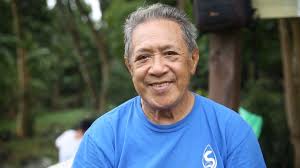Jean “Coco” Hotahota (Moorea-Maiao, French Polynesia, January 1, 1941 – Pirae, Tahiti, March 8, 2020) was one of the most influential figures in Polynesian traditional dance, especially ‘Ori Tahiti. A dancer, choreographer, musician, writer, costume designer, theater man, cultural innovator—his life was a song and a dance, entirely dedicated to his land, his roots, and the preservation and renewal of a living identity.
Early Life and Training
-
Coco Hotahota was born in Moorea-Maiao, part of the Society Islands in French Polynesia.
-
From an early age, he became involved in dance through Madeleine Moua’s troupe, one of the pioneers of cultural revival in Tahiti. That experience gave him a solid grounding in tradition, artistry, and cultural commitment.
Temaeva: His Creation, His Lifework

-
In 1962, Coco founded the troupe Temaeva (sometimes written Te Maeva), aiming to bring ‘Ori Tahiti to life in a way that was true to the traditional spirit but also open to innovation.
-
Temaeva went on to become the oldest existing troupe in Tahiti, and also one of the most decorated in the history of the Heiva i Tahiti, the central cultural competition-festival of the islands.
-
Coco oversaw nearly every aspect of his productions: writing the themes, composing the music, choreographing, designing costumes, and directing the stage performance.
Style, Innovation, and Controversies
Coco Hotahota did not simply reproduce older forms—his art constantly balanced tradition with modernity.
-
In the 1980s, his troupe won repeatedly at the Heiva, presenting increasingly ambitious productions in terms of scale, staging, and expressive power.
-
His work sometimes sparked controversy: scenes that some felt were provocative or challenged traditional codes—for example, the use of modern costumes, staging that reflected contemporary life, or powerful metaphorical images.
-
For Coco, this tension was essential. He believed Polynesian identity was not static but living, always in dialogue with change and modern influences.
Cultural Legacy, Teachings, and Values

Coco Hotahota’s influence reached far beyond the stage. Some of the most important aspects of his legacy include:
-
Love of country and culture – He emphasized not only dancing, but also cherishing the language, the land, and the values behind the movement.
-
Generational transmission – He directed Temaeva for nearly six decades, training and inspiring generations of dancers, choreographers, musicians, and designers. Many of today’s leading Polynesian artists once studied under him or performed in his troupe.
-
Balancing tradition and renewal – Coco knew when to return to essentials and when to embrace innovation—whether in themes, staging, music, or visual arts. His ability to modernize without betraying ancestral roots may be his greatest contribution.
-
Social and cultural awareness – Many of his performances contained elements of critique or reflection on issues such as youth, loss of values, and outside influence. His dance was not only beautiful but also socially conscious.
His Passing and the Tributes
-
Coco Hotahota passed away on March 8, 2020, in Pirae (Tahiti), at the age of 79, after a long illness.
-
His death was a profound loss for all of French Polynesia. A large public tribute was organized at To’ata Square—the very stage where many of Temaeva’s most memorable Heiva performances took place.
-
He was celebrated as a guardian of tradition and an icon whose work and vision will continue through his troupe and his students.
Importance for Polynesian Culture and Beyond
-
Coco Hotahota helped establish ‘Ori Tahiti not only as a festival or tourist attraction, but as a serious art form with aesthetic, social, and symbolic depth.
-
Through Temaeva, he gave Polynesian dance a global audience, making it both a cultural ambassador and a symbol of identity.
-
His work now forms part of the intangible heritage of not just French Polynesia but Oceania as a whole—an example of how culture can adapt and thrive while staying true to its roots.
-
His example also inspires today’s conversations about cultural preservation, identity, and the transmission of ancestral knowledge in a globalized world.



